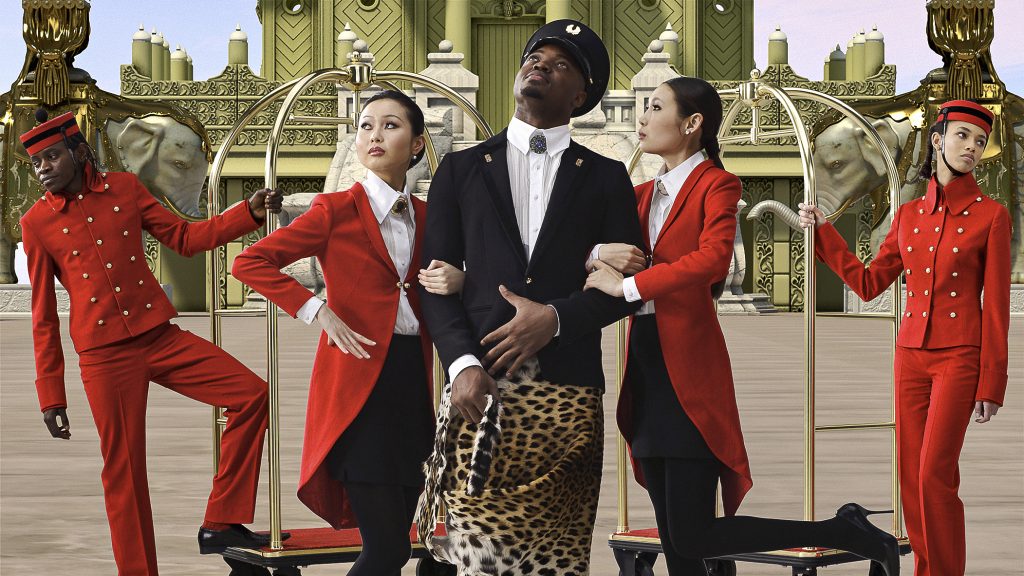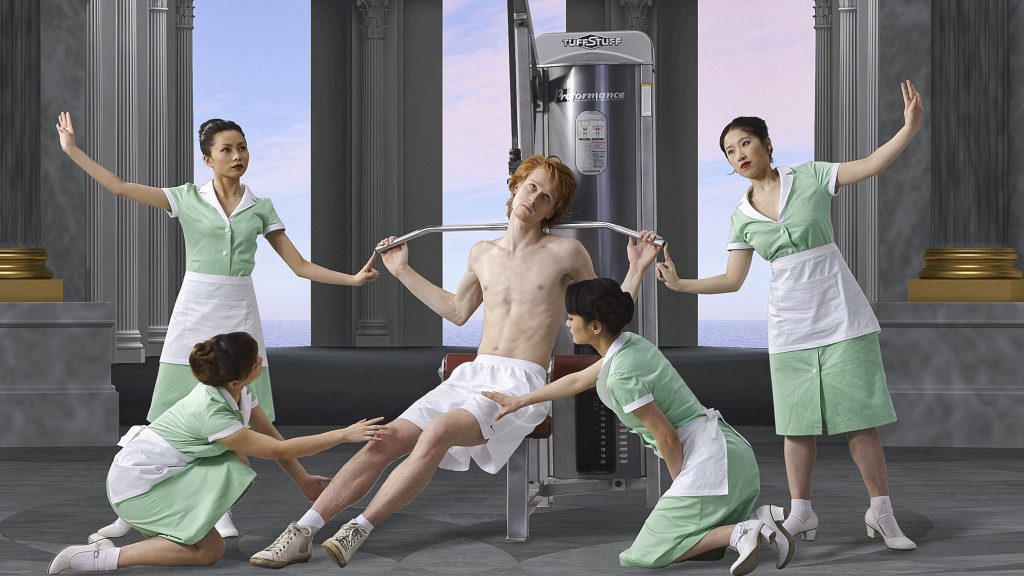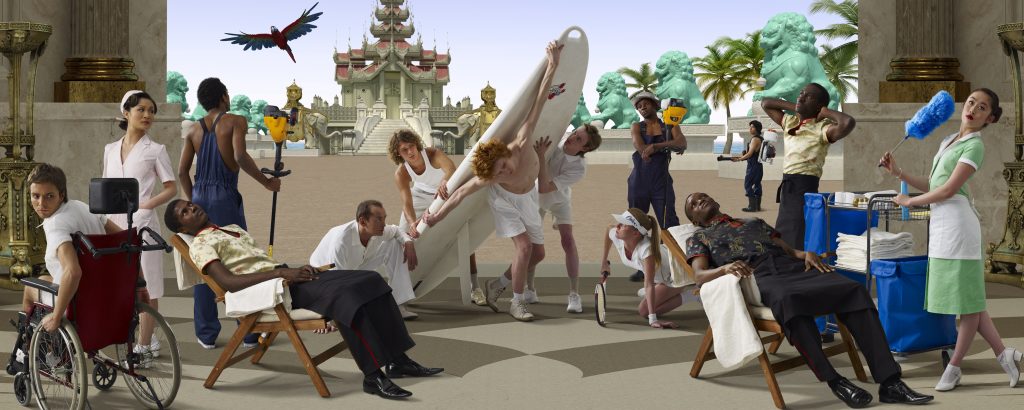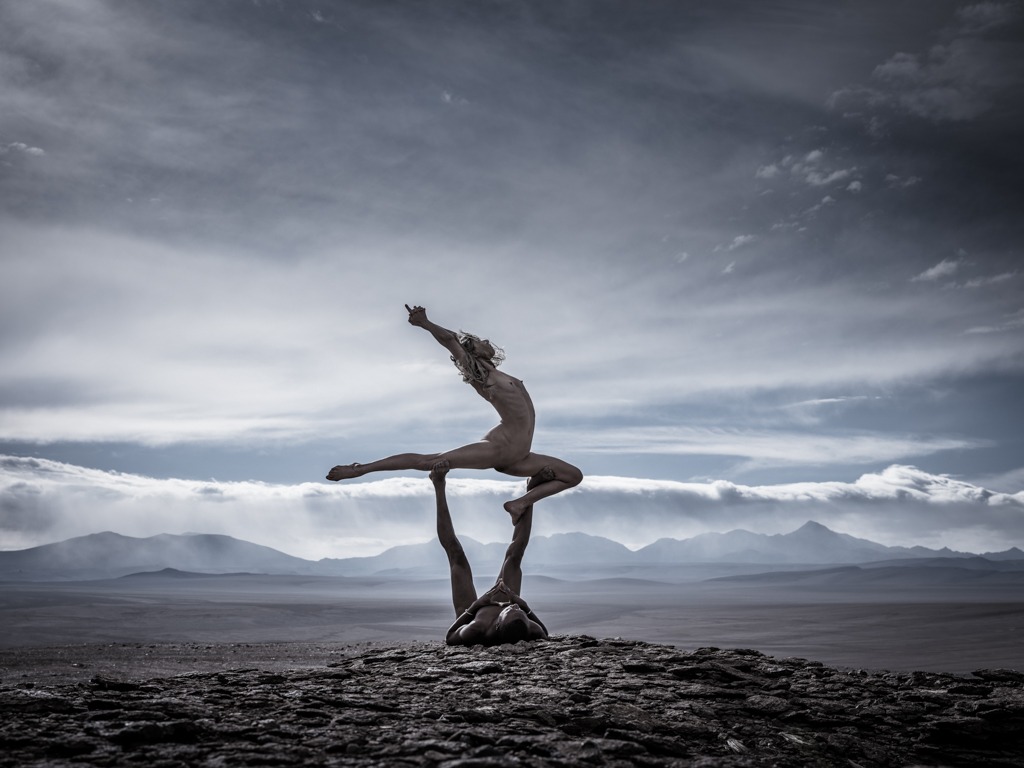In the Gyms of Art History
Calvin Klein meeting Caravaggio on the virtual postmodern dissection table: this is approximately what Gareth Harris has to say about the nature of beauty born in the works of the Russian AES+F group. And he has reason to do so. The grotesque decorum and beauty ideal of the video and photo series entitled The Feast of Trimalchio (2009-2010), presented as one of the attractions of the photo month of Bratislava, operates mainly with hybrid techniques similar to the ones implied above. It arranges the low, instinctive life of a perfectly decorated world into poses of classic paintings, and wraps up the concepts of beauty and disgust, drawn alarmingly close to each other, into a stern or derailed allegory of kitsch and the baroque ideals of elite art.
Petronius’s ancient novel is a report about decay, the super-satire of the Roman world. The nouveau riche downgrade culture, which is turned into a gruesome carnival, to become a charade, while history itself also becomes an obscene construction, a playground for “idiotic” politicians, a falsely composed orgy. One key to survival is rhetorical vigilance and a sense of humour sour as sarcasm.

The art group AES+F (Tatiana Arzamasova, Lev Evzovich, Evgeny Svyatsky and Vladimir Fridkes – the group’s name is an acronym formed from the initial letters of their family names) uses Petronius merely as a background pattern: their subject is a satire of the contemporary Russian nouveau riche, in the sense of Juvenalis’s claim that in certain ages it is difficult not to write satires. The characters satisfy their “cultural” needs on a luxury island; these needs revolve around the often theatrical hedonism of a wellness-worldview, and lead to the exposure of the emotional, sensual and sexual void behind their perceived superiority. In this fake paradise of the “natives”, the concentrated presence of European and Asian kitsch combined turns into beauty itself: exercise, massage, meals, naps become theatrical rituals in spaces constructed with an amazing renaissance and baroque logic.
The at times repetitive, and at times intermittent music of Beethoven and Mozart enforces to the extremes the force of ballet-like movements and choreography: “classicism” represses the background and pushes forth the baroque monster lurking in every gaze and movement. Regularity, symmetry and changing formations are prevalent; the guests’ “needs” are gradually taken over by the bodies of the employees offered as sexual objects representing the exotic world, and “conquer” their emptied “culture” in exchange, while clinging still to the baroque theatricality and ironic ancient hierarchy of the characters.

The guests’ interactions with one another are also ritualistic, and every action or situation leads to the creation of a grand, neo-baroque, hyperrealistic tableau. The iconographically strongly coded depictions of Saint Sebastian, Christ, or Diana with the arrow are joined by others too, but all of them are subordinated to the effects of light and shadow and the technical virtuosity of the play with perspectives. The pose of Christ when taken down from the cross appears during the languid exercise on a training equipment, Diana’s during a feast, Venus emerging is also the imitation of a parvenu tourist. This is the up-to-date remake of a dozen or so classic paintings: an arsenal of a fantastic art-kitsch-gallery, the fitness gym of art history, but also the dominance of luxurious, beautiful(ly shaped) bodies following the aesthetics of camp, a supermodel invasion. The fetish-like culture of the young body is further increased by the rhapsodic appearance of old bodies. The plot of the video coagulates into grandiose poetic tableaus, culminating in either perfect destruction or the ecstatic pain of the desire for harmony.

The luxury hotel becomes a micro-society where the paradise of hedonism is constructed by written and unwritten laws, the “entertainment” of the guests becomes a form of life, formal situations become dramatic, the surface beauty becomes an indicator of a miserable soul. This micro-world drowning in constant seduction and hedonistic metacommunication, this nice little utopia, despite all the visual effects, does not enthral the viewer with its sensuality. The viewer is instead absorbed by the satire that has this all-encompassing theatrical eroticism as its instrument. The idealised world of the luxury hotel leads through the classic patterns of sunlight, food, sports and relaxation to the futuristic experience of technology and a pervasive sensuality, but the fundamental human values are utterly missing or exiled from this compressed empire. Everything shines in bright colours; if it weren’t sheer blasphemy, I’d say: with the brightness of religious images. The actions that take place cannot always be understood, just like in the simultaneity of real life; various self-stylised images step into shared spaces or get excluded from these. The still life as an artificial, constructed form is equal in significance with the exaggerated idyllic life.
The concepts of time also follow the idealistic images, meaning not just the ideal of youth, but also a hedonistic kind of climate, combining at the same space and time a tropical seaside and skiing in the Alps, easily bringing together a table tennis ball and the globe, enlarging and narrowing dimensions, where the paid hedonism conquers every possible level.

It is not quite clear to me why the organizers of the exhibition joined the work of the AES+F group and Tom Jacobi’s nature photography into one common, albeit somewhat separated, space. (I have seen five videos of the AES+F group in Genf for the first time – I would have loved to see some of these in Bratislava too). Jacobi has a similar way of working with symmetry and geometric constructions, but he is looking for the inner meanings of real, existing landscapes, phenomena, geological terrains, crystals, and if he gets uncertain, he might as well add some naked acrobats or a naked woman to the picture. Ansel Adams’ determination meets here with popular culture and landscape-kitsch. Colours are only used within other colours: he employs uncountable nuances of grey, black, blue, bronze and white. His colourless world is colourful in a very economical way. The title of his exhibition (Awakening) also refers to the beginning, the awakening, coming to consciousness rather than the unveiling of a ripe cultural rhetoric. His world deepens inwards, and easily exchanges representation for meditation. He even takes the sacred seriously: he exhibits a triptych whose parts (Grey matter(s), Into the light, Inner light) express the stations of the path to enlightenment, and lead from the matter to spiritual dimensions.
The two worlds can empower each other’s forces as opposite poles: from the over-stylised gyms of art history one may look at an over-stylised landscape.
AES+F: The Feast of Trimalchio, Tom Jacobi: Awakening.
Bratislava, Dom umenia (Kunsthalle), 30. 10. 2019 – 30. 11. 2019
Ha tetszik, amit csinálunk, kérünk, szállj be a finanszírozásunkba, akár csak havi pár euróval!
